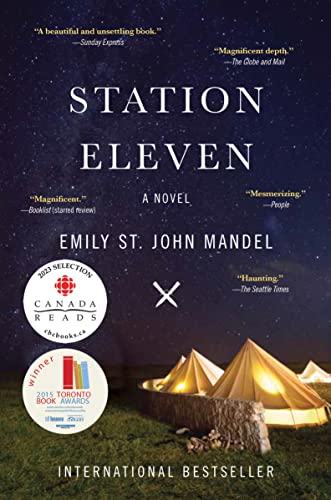Welcome, fellow bookworms! Today, I’m reviewing Station Eleven, a post-apocalyptic wonder by Emily St. John Mandel. This book is a wild rollercoaster of emotions, filled with deep character development and thought-provoking themes of survival. Grab your popcorn, because we’re about to dive into what makes this story tick and where it might hit a snag or two!
In a nutshell
Station Eleven by Emily St. John Mandel is a post-apocalyptic novel that weaves together the lives of diverse characters before, during, and after a flu pandemic wipes out most of humanity. The story explores themes of survival, art, and the interconnectedness of human lives through a traveling symphony that performs Shakespeare plays. It’s a thought-provoking read that makes you ponder what it means to live and what is worth preserving when the world falls apart.
The Intriguing World of the Post-Apocalyptic Genre
Have you ever wondered what life would be like after a global catastrophe? The post-apocalyptic genre takes you there, painting vivid pictures of survival, chaos, and hope. One of the most engaging reads in this genre is Station Eleven. This book hit me like a ton of bricks – in a good way. Imagine the world brought to its knees by a flu pandemic, and you have the setup.
In Station Eleven, author Emily St. John Mandel takes us on a journey through a broken world. I remember reading it while cuddled under a blanket, thinking, ‘Man, I am glad this is fiction!’ The story follows multiple characters, connecting their lives in a way that makes you appreciate the intricate web of humanity. The Traveling Symphony, a group of actors and musicians, becomes the symbol of resilience.
Pros? The narrative is like a well-oiled machine, smoothly shifting between the different timelines. Every time it did, I kept thinking, ‘Wait, what happens next?’ The author has a real knack for detailed descriptions, making the eeriness of an empty world feel incredibly real. Cons? Well, at times, the pacing slows. Some parts felt like an old car struggling up a hill.
Still, the cons are minor bumps in an otherwise thrilling ride. The emotional depth and the way it explores art, memory, and what makes life worth living are standout features.
So, if you’re up for a rollercoaster in a post-apocalyptic landscape, Station Eleven should be your next read. Now, let’s move on to the next section, where we’ll talk about character development – the real bread and butter of any great story.
Character Development in Station Eleven
Character development is like the secret sauce in a book. You can have a great plot, but if the characters are flat, the whole dish falls apart. Station Eleven by Emily St. John Mandel nails it when it comes to character development. Right from the start, you get invested in the lives of the characters. And trust me, I’m a guy who once felt nothing for a character in a love triangle. But these folks? They feel like old friends!
We follow a handful of folks after a flu wipes out most of humanity. There’s Jeevan, who starts off as a failed paparazzo and finds his purpose in the new world. Then there’s Kirsten, a child actress who grows up to be a badass with a knife collection. Each character is layered and evolves in believable ways. I was rooting for them like I root for my favorite sports team—sometimes yelling at the book, much to my partner’s concern.
Even the minor characters get some love. They aren’t just there to move the plot along. Each one has a backstory that makes them feel real. The author uses flashbacks to show how these people were before the collapse and how it shaped who they become. It’s like getting to know your friends by looking at their high school yearbook photos. A mixture of cringe and warm fuzzies.
However, I did find some characters a bit too perfect. No one can juggle flaming swords and solve world hunger, right? But hey, I guess we all need heroes. In the next section, let’s break down the plot structure, a real rollercoaster of emotions and twists.
Plot Structure
The plot structure of Station Eleven is like a rollercoaster of emotions. I swear, if I had a Fitbit on while reading, it would have thought I was doing a HIIT workout. The narrative jumps between the past and the post-apocalyptic present, weaving a complex but engrossing tale. You’d think it’s confusing, but it’s not! It’s like one of those magic-eye puzzles—blur your eyes a bit, and it all comes together.
So, the book starts with a bang—literally! The actor Arthur Leander collapses during a performance of King Lear, and BAM, the Georgia Flu pandemic begins. The story then spirals out in multiple directions, following characters over decades. One minute you’re in the glitzy pre-flu world, and the next, you’re worrying about how to fend off marauding cultists. It’s like “Game of Thrones” had a baby with “The Walking Dead,” but, you know, with less backstabbing and more Shakespeare.
What makes the plot even better is its non-linear format. You get to see how the characters’ past lives influence their actions in the post-apocalyptic world. This adds depth and layers to the narrative, making it more than just another end-of-the-world story. You’ll find yourself flipping pages faster than a squirrel on Red Bull!
However, this hopping back and forth can sometimes be a bit much for readers who prefer a straightforward narrative. If I had a dollar for every time I had to re-read to make sure I was in the right timeline, I’d buy a coffee. Maybe two. But hey, all good things come at a price, right?
Next up, we’ll dive into the gripping themes of survival that make Station Eleven a must-read. Stay tuned!
Themes of Survival in Station Eleven
Survival is a core theme in Station Eleven by Emily St. John Mandel. It’s kind of like trying to keep your plants alive during a winter freeze – challenging but sometimes heartwarming. The post-apocalyptic world Mandel paints is brutal, and the characters must navigate this new normal.
Survival of the fittest or the kindest? The book delves into this with characters like Kirsten, who totes knives like a pro but also clings to memories of art and beauty. It makes you wonder what you’d do in a world teetering on the edge.
Another angle is the Traveling Symphony, a group of actors and musicians who perform Shakespeare plays. Talk about commitment! They embody the idea that survival isn’t just about food and shelter. It’s about preserving what makes us human. These little Shakespearean performances serve as lifelines, binding communities together in a harsh world.
The cost of survival is another theme. Jeevan, one of the characters, often faces moral dilemmas that test his limits. Imagine yourself pushing a shopping cart full of supplies through snow and wondering if you’ve become the person you feared.
Survival also has a different flavor for each character. For some, it’s physical survival. For others, it’s emotional – like preserving relationships or keeping hope alive.
In conclusion, the themes of survival make Station Eleven a gripping read. Do I recommend it? Absolutely! Whether you like pondering life’s big questions or just enjoy a good story, this book has something for everyone.
Conclusion
Wrapping things up, Station Eleven by Emily St. John Mandel is a stunning post-apocalyptic tale. You’ll meet characters who feel like old friends, and the non-linear plot will keep you on your toes. The themes of survival and art are compelling, and while some parts might seem a bit confusing, it’s a highly engaging read. This concludes my review. Happy reading!


